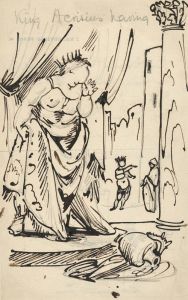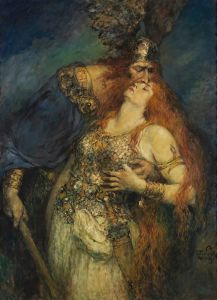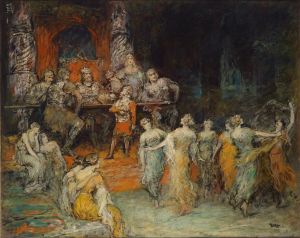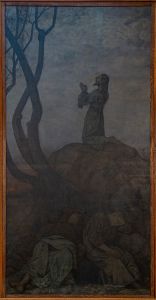
Siegfried im Walde
A hand-painted replica of Hans Thoma’s masterpiece Siegfried im Walde, meticulously crafted by professional artists to capture the true essence of the original. Each piece is created with museum-quality canvas and rare mineral pigments, carefully painted by experienced artists with delicate brushstrokes and rich, layered colors to perfectly recreate the texture of the original artwork. Unlike machine-printed reproductions, this hand-painted version brings the painting to life, infused with the artist’s emotions and skill in every stroke. Whether for personal collection or home decoration, it instantly elevates the artistic atmosphere of any space.
Hans Thoma's painting Siegfried im Walde (translated as Siegfried in the Forest) is a work by the German painter and graphic artist Hans Thoma (1839–1924). Thoma was a prominent figure in 19th-century German art, known for his landscapes, portraits, and mythological themes, often inspired by German folklore and Romanticism.
Siegfried im Walde depicts the legendary hero Siegfried, a central figure in Germanic mythology and the medieval epic Nibelungenlied. Siegfried is often portrayed as a dragon-slayer and a symbol of bravery and heroism. In this painting, Thoma places Siegfried in a forest setting, emphasizing the connection between the hero and the natural world. The forest, a recurring motif in German Romantic art and literature, serves as both a physical and symbolic space, representing mystery, danger, and the sublime.
Thoma's style in this work reflects his broader artistic approach, which combined elements of Romanticism and Realism. His use of naturalistic detail and harmonious color palettes creates a serene yet evocative atmosphere. The painting captures a moment of introspection or calm before action, rather than focusing on dramatic or violent scenes often associated with Siegfried's legend. This approach aligns with Thoma's preference for contemplative and idyllic representations of mythological subjects.
Hans Thoma was influenced by the German Romantic tradition, as well as by artists such as Albrecht Dürer and the Nazarene movement. His works often reflect a deep appreciation for nature and a desire to connect with Germany's cultural heritage. Siegfried im Walde is an example of how Thoma integrated these influences into his art, creating a piece that resonates with both historical and mythological significance.
The painting is part of Thoma's broader body of work, which includes numerous depictions of mythological and allegorical themes. While specific details about the creation date or current location of Siegfried im Walde are not readily available, it remains an example of Thoma's ability to blend mythological storytelling with his distinctive artistic vision.
Hans Thoma's contributions to German art earned him recognition during his lifetime, and his works continue to be appreciated for their technical skill and thematic depth. Siegfried im Walde exemplifies his talent for capturing the essence of mythological figures within the context of nature, offering viewers a glimpse into the enduring power of Germanic legends.


















